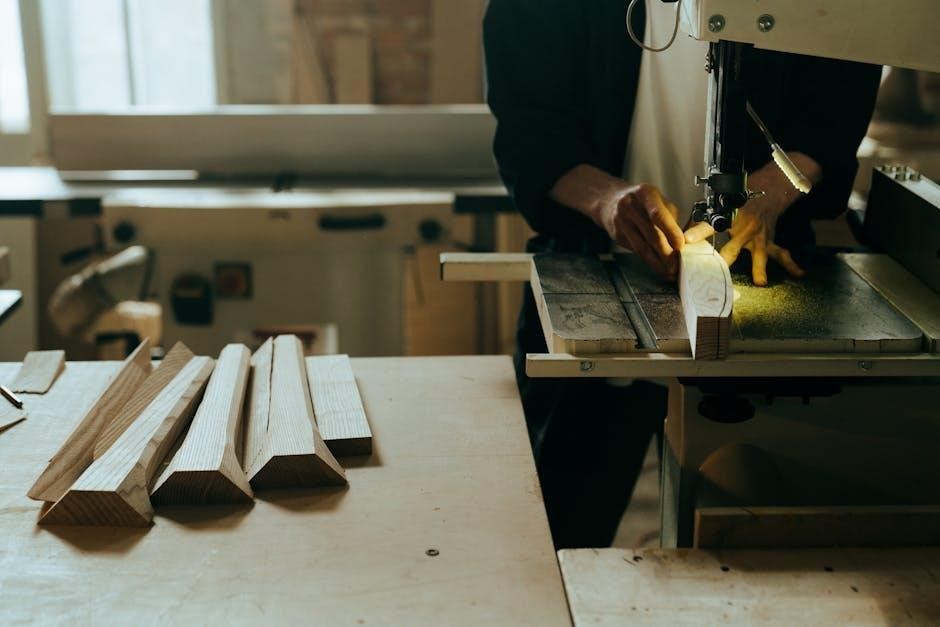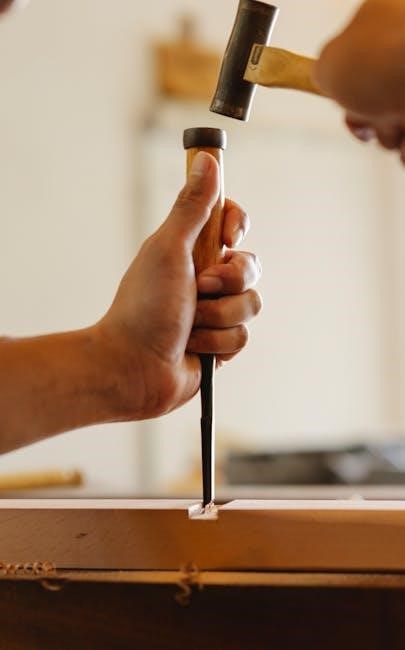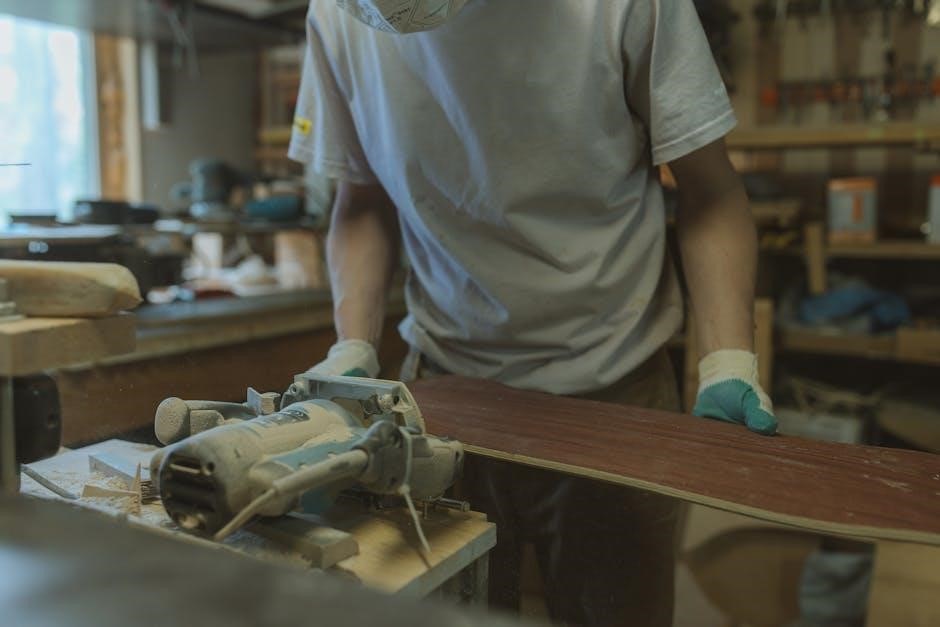Welcome to the Craftsman Manual Miter Saw guide․ This comprehensive manual provides essential insights into safety, setup, and operation for optimal performance and precision cutting․
1․1 Overview of the Craftsman Miter Saw
The Craftsman Manual Miter Saw is a versatile power tool designed for precise crosscuts and angled cuts in woodworking projects․ It features a robust design with a 10-inch blade, capable of handling materials up to 2×8 inches․ The saw includes positive stops at common angles like 0°, 15°, 22․5°, 31․6°, and 45°, ensuring accuracy for crown molding and trim work․ Its compact build and user-friendly controls make it ideal for both DIY enthusiasts and professionals․ The manual provides detailed guidance on setup, operation, and maintenance to maximize performance and longevity․
1․2 Importance of the Manual for Optimal Use
The manual is crucial for understanding safety guidelines, assembly, and operation of the Craftsman Miter Saw․ It provides detailed instructions to ensure proper setup, maintenance, and troubleshooting, maximizing performance and longevity․ By following the manual, users can avoid common errors, enhance cutting accuracy, and safely handle complex projects․ Regular maintenance tips and diagnostic solutions are included to keep the tool functioning optimally․ Adhering to the manual’s recommendations ensures precision, durability, and consistent results in woodworking tasks․

Product Specifications
The Craftsman Manual Miter Saw, model 113235200, features a 10-inch blade, 15-amp motor, and 40-tooth count․ It offers a 2×8 crosscut capacity and positive stops at 0°, 15°, 22․5°, 31․6°, and 45°․
2․1 Key Features of the Craftsman Miter Saw
The Craftsman Miter Saw is designed for precision and versatility, featuring a powerful motor, a high-quality blade, and adjustable miter and bevel settings․ It includes positive stops at common angles like 0°, 15°, 22․5°, 31․6°, and 45°, ensuring accurate cuts․ The saw also boasts an ergonomic handle for comfortable operation, a dust collection system to minimize mess, and compatibility with various accessories for enhanced functionality․ These features make it ideal for both DIY projects and professional carpentry tasks, offering reliability and efficiency for a wide range of cutting needs․
2;2 Motor Power and Blade Size
The Craftsman miter saw is equipped with a robust 1․75 HP motor, ensuring consistent power for precise cuts․ The 10-inch blade size provides versatility for various cutting tasks, from trim work to larger lumber․ With a maximum RPM of 4,000, the saw delivers smooth operation across different materials․ The motor’s power and blade size are optimized for efficiency, allowing users to handle both DIY projects and professional carpentry with ease․ This combination ensures reliable performance, making it a versatile tool for woodworking enthusiasts and professionals alike․
2․3 Cutting Capacity and Precision
The Craftsman miter saw offers impressive cutting capacity, capable of crosscutting a 2×8 material effortlessly․ Its precision is enhanced by positive stops at 0°, 15°, 22․5°, 31․6°, and 45°, ensuring accurate angle cuts․ The 10-inch blade delivers clean cuts, while the robust motor maintains consistent power․ Designed for versatility, it excels in crown molding and trim work, though larger materials may require adjustments․ This saw balances power and accuracy, making it ideal for both DIY projects and professional carpentry, ensuring precise results across various applications․

Safety Guidelines
Always inspect the saw before use, wear protective gear, and keep loose clothing tied back․ Ensure the work area is clear and follow proper post-use storage procedures․
3․1 Pre-Use Safety Checks
Before operating the Craftsman Miter Saw, ensure all safety measures are in place․ Inspect the blade for damage or dullness and replace if necessary․ Verify the work area is clear of debris and obstructions․ Check for loose parts and ensure all guards are functioning properly․ Confirm the power cord is undamaged and plugged into a grounded outlet․ Wear protective gear, including safety goggles and a dust mask․ Always ensure the saw is placed on a stable, flat surface․ Familiarize yourself with the emergency stop feature and ensure it is easily accessible․ Never start the saw near flammable materials or in hazardous environments․
3․2 Operating Safety Tips
- Always wear safety glasses and a dust mask when operating the saw to protect against debris and dust․
- Ensure loose clothing and long hair are tied back to avoid entanglement with moving parts․
- Never operate the saw while distracted or fatigued to maintain full control․
- KKeep hands away from the blade during operation, and avoid reaching over the cutting area․
- Use a push stick for smaller workpieces to maintain a safe distance from the blade․
- Ensure the saw is placed on a stable, flat surface to prevent accidental movement․
- Always use the correct blade type for the material being cut to minimize kickback risks․
- Keep children and pets away from the workspace while the saw is in use․
- Turn off the saw when not in use and allow the blade to stop completely before leaving it unattended․
3․3 Post-Use Safety Procedures
After completing your cuts, ensure the blade comes to a complete stop before leaving the saw unattended․ Disconnect the power source and remove the blade for safe handling․ Clean the saw and surrounding area to prevent debris buildup․ Inspect the tool for damage or wear, addressing issues promptly․ Store the saw in a secure, dry location out of reach of children․ Regularly check and maintain the blade’s condition to ensure optimal performance and safety in future use․
Assembly and Setup
Begin by carefully unpacking and inventorying all parts․ Follow the manual’s step-by-step guide for assembling the miter saw, ensuring proper alignment and secure tightening of components․
4․1 Unpacking and Inventory of Parts
Unpacking your Craftsman Miter Saw is an exciting first step․ Carefully remove all components from the box and place them on a clean, flat surface․ Inspect each part for damage or defects․ The package should include the miter saw, blade, fence, dust bag, and various accessories like wrenches and clamps․ Refer to the parts diagram in the manual to ensure no items are missing․ Organize the parts neatly, separating hardware and tools․ This step is crucial for a smooth assembly process․ Take your time to verify the inventory, as missing parts can delay setup․ Store unused items securely for future use․
4․2 Step-by-Step Assembly Instructions
- Begin by attaching the miter saw to a sturdy workbench or stand using the provided mounting hardware․
- Install the fence by aligning the pre-drilled holes and securing it with the included bolts․
- Attach the blade guard and ensure it moves freely without obstruction․
- Connect the dust collection port to a vacuum or dust bag for efficient cleanup․
- Verify the saw’s alignment by checking the blade’s position relative to the fence;
- Tighten all connections and test the saw at a low speed before making cuts․
Ensure all parts are securely fastened for safe and accurate operation․
4․3 Calibration and Alignment
Calibration ensures your Craftsman miter saw operates accurately․ Start by adjusting the miter angle to 0° and verifying it with a square․ Align the blade to the fence using a wrench and check for squareness․ Tighten all locking knobs securely․ For bevel alignment, set the angle to 0° and ensure the blade is perpendicular to the table․ Use the manual’s guidance for precise adjustments․ Regular calibration prevents errors in cuts and extends tool longevity․ Always refer to the manual for specific calibration steps tailored to your model․

Parts and Accessories

Explore the essential components and accessories for your Craftsman Miter Saw, including blades, clamps, and laser guides, to enhance cutting accuracy and workflow efficiency․

- Refer to the parts diagram for detailed component identification․
- Discover must-have accessories like dust bags and stands․
5․1 Understanding the Parts Diagram
The parts diagram in your Craftsman Miter Saw manual is a detailed visual guide that labels and explains each component of the tool․ It helps you identify and locate parts like the motor, blade, miter scale, and safety guards․ Understanding this diagram is crucial for assembly, maintenance, and troubleshooting․
Use the diagram to familiarize yourself with key components, such as the power switch, dust collection port, and fence․ It also highlights adjustable features like miter and bevel controls․ Referencing the diagram ensures accurate assembly and helps you order replacement parts efficiently․
5․2 Essential Accessories for Enhanced Performance
To maximize the efficiency of your Craftsman Miter Saw, consider investing in essential accessories․ A miter saw stand provides stability and portability, while a high-quality blade sharpener maintains blade precision․ A dust collection kit helps keep your workspace clean, reducing dust-related hazards․ Additionally, a laser guide enhances cutting accuracy, and a work light improves visibility․ These accessories not only improve performance but also extend the lifespan of your tool․ Ensure compatibility with your model for optimal results․

Operating the Miter Saw
Master precise crosscuts and angled cuts with the Craftsman Miter Saw․ Use miter and bevel settings for crown molding and trim, leveraging positive stops for consistent accuracy and efficiency․
6․1 Basic Cutting Techniques
Mastering basic cutting techniques with the Craftsman Miter Saw ensures accuracy and safety․ Start by aligning the material firmly against the fence and securing it with clamps․ Always maintain a steady grip on the saw handle, keeping your body positioned to avoid kickback․ Lower the blade smoothly and consistently, applying gentle to moderate pressure․ Use the positive stops at 0°, 15°, 22․5°, 31․6°, and 45° for quick, precise angle adjustments․ Keep the workpiece stable throughout the cut to achieve clean, professional results․ Practice these techniques to enhance your woodworking efficiency and precision․
6․2 Adjusting Miter and Bevel Angles
Adjusting miter and bevel angles on the Craftsman Miter Saw ensures precise cuts for various projects․ To set the miter angle, rotate the miter handle to the desired degree, using the positive stops at 0°, 15°, 22․5°, 31․6°, and 45° for quick adjustments․ For bevel adjustments, tilt the saw to the left or right, aligning the bevel gauge with your target angle․ Fine-tune both settings using the adjustment knobs for accuracy․ Always double-check your angles before cutting to ensure the best results․ This feature enhances versatility, making it ideal for crown molding, trim work, and complex woodworking designs․
6․3 Using Positive Stops for Precision
Positive stops on the Craftsman Miter Saw enhance accuracy by locking the blade at common angles like 0°, 15°, 22․5°, 31․6°, and 45°․ These preset positions eliminate manual adjustments, ensuring precise cuts for crown molding and trim․ To use, align the blade with the desired stop, lock it in place, and confirm the angle before cutting․ This feature saves time and reduces errors, especially for repetitive cuts․ For optimal results, test the stops with scrap material to ensure alignment accuracy․ Regularly check and clean the stops to maintain their effectiveness․ This ensures consistent, professional-quality cuts every time․

Maintenance and Troubleshooting
Regularly inspect the blade for wear, clean dust from the saw, and lubricate moving parts․ Address common issues like misalignment or motor overload promptly for optimal performance․
7․1 Regular Maintenance Tips
Regular maintenance ensures optimal performance and longevity of your Craftsman Miter Saw․ Clean the saw regularly, removing dust and debris from the blade and cutting area․ Check for blade dullness and sharpen or replace it as needed․ Lubricate moving parts to prevent friction and wear․ Inspect the fence and miter scales for accuracy and tighten any loose components․ Store the saw in a dry, clean environment to prevent rust․ Follow the manufacturer’s recommendations for blade maintenance and replacement․ Proper care will enhance precision and safety during operation․
7․2 Common Issues and Solutions
Common issues with the Craftsman miter saw include blade wear, misalignment, and motor overheating․ For blade wear, replace the blade regularly․ Misalignment can be fixed by recalibrating the fence and blade․ Overheating often occurs due to dust buildup; ensure proper ventilation and clean the saw regularly․ If the saw vibrates excessively, check and tighten all bolts․ For accuracy issues, verify that the miter and bevel angles are set correctly․ Lubricate moving parts periodically to maintain smooth operation․ Always refer to the manual for specific troubleshooting steps to ensure optimal performance and longevity of your tool․
7․3 Blade Sharpening and Replacement
Regular blade sharpening and replacement are crucial for maintaining the performance of your Craftsman miter saw․ A dull blade can lead to uneven cuts and increased wear on the motor․ Sharpen the blade when you notice a decrease in cutting precision or if it becomes visibly worn․ For replacement, ensure the new blade matches the specifications in the manual․ Use a wrench to loosen the arbor bolt, carefully remove the old blade, and install the new one․ Always follow safety guidelines and use proper tools to avoid injury or damage․ Proper blade maintenance ensures accurate cuts and extends the life of your saw․

Advanced Features and Techniques
Explore compound cuts, crown molding, and optimized settings for precision․ Master bevel and miter combinations, enabling intricate designs with enhanced accuracy and efficiency․
8․1 Compound Cuts and Crown Molding
Mastering compound cuts and crown molding with the Craftsman Miter Saw enhances your woodworking projects․ Compound cuts involve simultaneous miter and bevel adjustments, perfect for intricate trim work․ Crown molding requires precise angle settings to achieve flush joints․ The saw’s miter and bevel stops at 0°, 15°, 22․5°, 31․6°, and 45° simplify cutting crown molding․ Use the saw’s crosscut capacity to handle 2×8 materials effortlessly․ For professional results, ensure accurate angle alignment and steady blade control․ Practice on scrap material to refine your technique before tackling final pieces․
8․2 Bevel and Miter Combination Cuts
Combining bevel and miter cuts allows for intricate angles, ideal for crown molding or complex trim work․ Set the miter angle first, then adjust the bevel to achieve the desired compound cut․ Use the positive stops for quick adjustments at common angles like 15°, 22․5°, or 31․6°․ Ensure the blade is aligned properly before cutting․ Practice on scrap material to perfect the technique․ This feature enhances precision and versatility, making it essential for professional-grade woodworking projects․ Always refer to the manual for specific angle settings and safety guidelines when performing combination cuts․
8․4 Optimizing Cutting Accuracy
To achieve precise cuts with your Craftsman miter saw, ensure proper alignment of the blade and fence․ Use the positive stops at 0°, 15°, 22․5°, 31․6°, and 45° for consistent miter angles․ Calibrate the saw regularly and maintain a sharp blade for clean cuts․ For complex projects like crown molding, practice compound cuts by adjusting both miter and bevel angles․ Use test cuts on scrap wood to verify accuracy before working on final pieces․ Employ jigs or guides for repetitive cuts, and always secure the workpiece firmly to prevent movement during operation․ These techniques ensure professional-grade results every time․

Projects and Applications
Explore various projects using the Craftsman Miter Saw, from DIY woodworking to professional carpentry․ Perfect for crown molding, trim work, and custom furniture․ Versatile and precise․
9․1 DIY Woodworking Projects
The Craftsman Manual Miter Saw is a versatile tool for various DIY woodworking projects․ It excels in precision cutting for tasks like crown molding, picture frames, and custom furniture․ With its ability to make accurate miter and bevel cuts, it simplifies projects such as building a backyard bench, installing shelving, or creating decorative trim․ The saw’s portability and ease of use make it ideal for hobbyists and DIY enthusiasts looking to enhance their home decor or create functional items․ Its preset angle stops also streamline repetitive cuts, making it perfect for intricate designs and detailed woodworking creations․
9․2 Professional Uses in Carpentry
The Craftsman Manual Miter Saw is a valuable tool for professional carpenters, enabling precise cuts for various projects․ Its accuracy makes it ideal for installing crown molding, cutting trim, and fitting large timbers․ The saw’s ability to crosscut 2×8 lumber and its preset miter and bevel angles simplify tasks like framing and custom woodworking․ Professionals rely on its durability and consistency to deliver high-quality results efficiently, making it an essential asset in both small-scale and large carpentry projects․
Mastery of the Craftsman Manual Miter Saw requires adherence to safety guidelines, proper setup, and technique․ Regular maintenance ensures longevity and optimal performance for precise cuts every time․
10․1 Summary of Key Takeaways
The Craftsman Manual Miter Saw is a versatile tool designed for precision cutting․ Always follow safety guidelines, including pre-use checks and proper operating techniques․ Assemble and calibrate the saw carefully for optimal performance․ Regular maintenance, such as blade sharpening and cleaning, ensures longevity․ Troubleshoot common issues promptly to avoid downtime․ Master basic and advanced cutting techniques, like compound cuts and crown molding, for professional results․ Refer to the parts diagram for accessories and upgrades․ By adhering to the manual’s instructions, you can maximize the saw’s potential and achieve accurate, efficient cuts in various woodworking projects․
10․2 Final Tips for Long-Term Use
For long-term use, regularly clean the saw to prevent dust buildup․ Store the tool in a dry place to avoid rust․ Always use the correct blade type for your project to maintain performance․ Keep the manual handy for quick reference․ Lastly, ensure proper calibration and blade alignment to maintain accuracy and extend the tool’s lifespan․
- Clean the saw after each use to prevent dust accumulation․
- Inspect for wear and tear on moving parts․
- Store blades separately to avoid damage․
- Follow the manual for proper setup and operation․
By adhering to these tips, you’ll ensure your Craftsman Miter Saw remains reliable for years of precise cutting․
